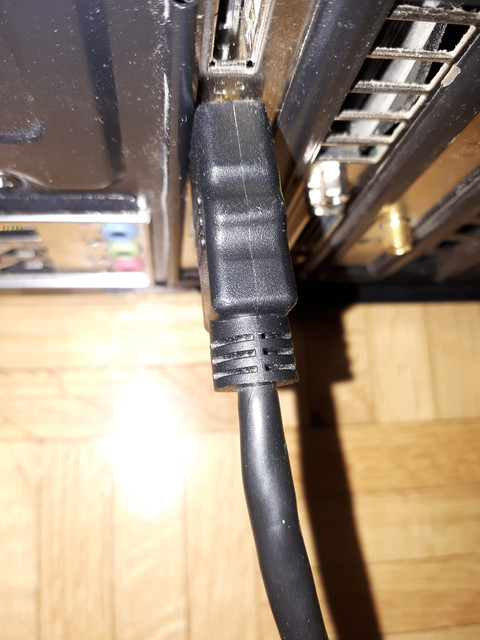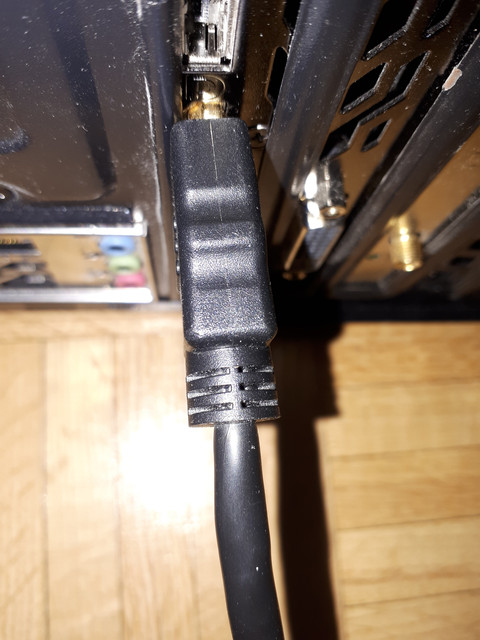Hi everyone! I know, yet again another "TV not working with a computer" problem, sorry if you saw this a million times but I spent hours on the Internet looking for a solution. As a matter of fact, my problem is very similar to this post on another forum, which didn't receive a solution: https://forums.tomsguide.com/threads/hdmi-pc-detects-tv-but-tv-receives-no-signal.395870/
To keep it short: when I am plugging my HDMI cable from my computer to my TV, the computer detects the TV, I can extend the display and everything behaves as if I had two screens, but I can't see anything on the TV, I can't even switch to the HDMI port the cable is plugged in because there is no signal.
Here are more details:
Five years ago I bought a computer with two monitors and a Samsung smart TV (model: UN40H5203). The two monitors always worked fine together, one plugged-in via DVI and the other via HDMI, never had any trouble with them. I seldom plugged my computer to the TV, but when I did I always managed to get it work.
Troubles started at the end of 2018 when I switched my graphics card from a Radeon R9 270X 2GB to a NVidia GeForce GTX 1060 6GB. The next time I tried to connect my PC to my TV, it didn't work. I ultimately managed to make it work by removing the drivers of the old graphics card, although I can't find how I did it again.
Now, a little more than a year later, I have the same problem. I don't know what changed since then. The weirdest thing is that I have a laptop with Windows 10 and an integrated chipset who works perfectly with the TV, as soon as I connect the HDMI cable the display switches immediately to the TV. In order to have my desktop detect the TV, I need to restart it, it doesn't seem to be able to detect it right away like the laptop does. I sometimes had to restart it as well when plugging the second monitor back in, although it generally detects it right away.
I tried getting everything up-to-date on my desktop: I updated the BIOS, the graphics card drivers, I even upgraded from Windows 7 to Windows 10 (I thought that might be the culprit since the laptop works fine), nothing changes. I plug the desktop with the same HDMI cable into the same TV port as the laptop. I tried changing cables and ports, same results.
The only difference I can spot between the laptop and the desktop is that the TV is detected on the desktop as a "Generic PnP Monitor", an audio input and output, but also as a"Digital Media Device" and a "Software Device", which doesn't happen on the laptop (it only appears as a "Generic PnP Monitor" and an audio input and output). Could it be an hint?
[Edit]
It turns out that the name I could see in the Digital Media Device and the Software Device sections is the name of my TV on the Wi-Fi network. If I disconnect my TV from the Wi-Fi, it doesn't appear there anymore. I still don't understand why it wouldn't appear on the laptop, maybe it's about the laptop being on the Wi-Fi while the desktop is on LAN, but I don't see why it would be that way since the TV is on the Wi-Fi. Anyway, I guess we can ignore that.
[/Edit]
Thanks a lot in advance for your help, I am running out of solutions!
To keep it short: when I am plugging my HDMI cable from my computer to my TV, the computer detects the TV, I can extend the display and everything behaves as if I had two screens, but I can't see anything on the TV, I can't even switch to the HDMI port the cable is plugged in because there is no signal.
Here are more details:
Five years ago I bought a computer with two monitors and a Samsung smart TV (model: UN40H5203). The two monitors always worked fine together, one plugged-in via DVI and the other via HDMI, never had any trouble with them. I seldom plugged my computer to the TV, but when I did I always managed to get it work.
Troubles started at the end of 2018 when I switched my graphics card from a Radeon R9 270X 2GB to a NVidia GeForce GTX 1060 6GB. The next time I tried to connect my PC to my TV, it didn't work. I ultimately managed to make it work by removing the drivers of the old graphics card, although I can't find how I did it again.
Now, a little more than a year later, I have the same problem. I don't know what changed since then. The weirdest thing is that I have a laptop with Windows 10 and an integrated chipset who works perfectly with the TV, as soon as I connect the HDMI cable the display switches immediately to the TV. In order to have my desktop detect the TV, I need to restart it, it doesn't seem to be able to detect it right away like the laptop does. I sometimes had to restart it as well when plugging the second monitor back in, although it generally detects it right away.
I tried getting everything up-to-date on my desktop: I updated the BIOS, the graphics card drivers, I even upgraded from Windows 7 to Windows 10 (I thought that might be the culprit since the laptop works fine), nothing changes. I plug the desktop with the same HDMI cable into the same TV port as the laptop. I tried changing cables and ports, same results.
The only difference I can spot between the laptop and the desktop is that the TV is detected on the desktop as a "Generic PnP Monitor", an audio input and output, but also as a"Digital Media Device" and a "Software Device", which doesn't happen on the laptop (it only appears as a "Generic PnP Monitor" and an audio input and output). Could it be an hint?
[Edit]
It turns out that the name I could see in the Digital Media Device and the Software Device sections is the name of my TV on the Wi-Fi network. If I disconnect my TV from the Wi-Fi, it doesn't appear there anymore. I still don't understand why it wouldn't appear on the laptop, maybe it's about the laptop being on the Wi-Fi while the desktop is on LAN, but I don't see why it would be that way since the TV is on the Wi-Fi. Anyway, I guess we can ignore that.
[/Edit]
Thanks a lot in advance for your help, I am running out of solutions!
Last edited:



